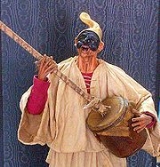
Putipù
Encyclopedia
One of the most original instruments created by the folkloristic inventiveness, generally of the South of Italy and in a particular way Neapolitan, is the “Caccavella”, which for onomatopoeia,
Is called by the populace “Putipu”.
This instrument is considered a friction drum and is also called “Pernacchiatore”, “Puti-Puti”, “Pignato”, “Cute-Cute”, “Cupellone”, “Pan-bomba” (of Spanish origin), and “Cupa-cupa”(especially in Apulia).
The “Caccavella” (or Putipù) is made of:
a sound box;
a film of skin or of a heavy cloth;
a bamboo cane.
The sound box, decorated along the edge with coloured ribbons, could have been made of:
An earthenware pan, as in the “caccavella” and in the “pan – bomba” (the earthenware is a high quality clay which is used in the Southern part o Italy for making vases, plates and cooking pans);
A wooden tub (small for the “putipù”, bigger for the “cupellone”);
A tin can (often are used big tomatoes cans).
When animal skins were not available, the film of skin (which was generally of goat, sheep or rabbit, very rarely it was of donkey or of ruminants such as the calf) was substituted with a thick cloth.
The lower end of the bamboo cane (while on the topper end was applied a bow or other decoration) was inserted in a hole made in the middle of the membrane; the two things were tightly tied and fixed on the superior edge of the sound box.
Rubbing the bamboo cane up and down (with a wet hand, a wet cloth or a wet sponge) vibrations are induced in the skin which are amplified by the air inside the sound box (earthenware pan, wooden tub or tin can) producing the characteristic, humoristic, sometimes disquieting, sound.
Is called by the populace “Putipu”.
This instrument is considered a friction drum and is also called “Pernacchiatore”, “Puti-Puti”, “Pignato”, “Cute-Cute”, “Cupellone”, “Pan-bomba” (of Spanish origin), and “Cupa-cupa”(especially in Apulia).
The “Caccavella” (or Putipù) is made of:
a sound box;
a film of skin or of a heavy cloth;
a bamboo cane.
The sound box, decorated along the edge with coloured ribbons, could have been made of:
An earthenware pan, as in the “caccavella” and in the “pan – bomba” (the earthenware is a high quality clay which is used in the Southern part o Italy for making vases, plates and cooking pans);
A wooden tub (small for the “putipù”, bigger for the “cupellone”);
A tin can (often are used big tomatoes cans).
When animal skins were not available, the film of skin (which was generally of goat, sheep or rabbit, very rarely it was of donkey or of ruminants such as the calf) was substituted with a thick cloth.
The lower end of the bamboo cane (while on the topper end was applied a bow or other decoration) was inserted in a hole made in the middle of the membrane; the two things were tightly tied and fixed on the superior edge of the sound box.
Rubbing the bamboo cane up and down (with a wet hand, a wet cloth or a wet sponge) vibrations are induced in the skin which are amplified by the air inside the sound box (earthenware pan, wooden tub or tin can) producing the characteristic, humoristic, sometimes disquieting, sound.

